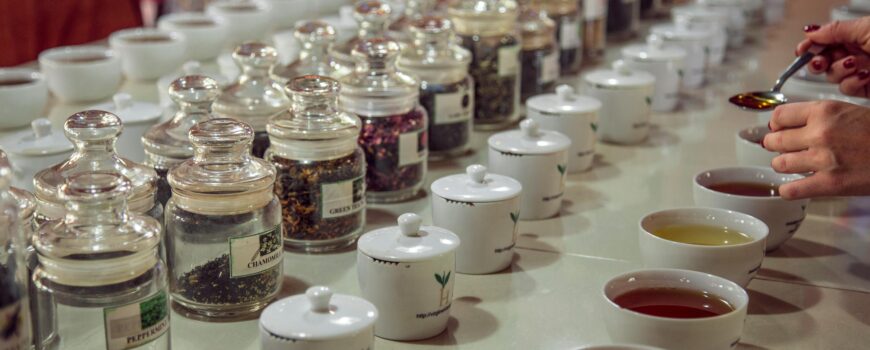A tea tasting set is a collection of specialized tools and utensils designed to facilitate the professional evaluation and enjoyment of tea. These sets are used by tea sommeliers, buyers, and enthusiasts to assess the quality, flavor, aroma, and appearance of different teas. Here’s an overview of the components of a tea tasting set and how it enhances the tea tasting experience.
Components of a Tea Tasting Set
- Tasting Cups:
- Small, white porcelain cups are used to examine the color and clarity of the tea liquor. The white color helps in accurately judging the tea’s hue without any color distortion.
- Tasting Bowls:
- Larger bowls are used for steeping the tea leaves. These are usually white porcelain to allow for clear observation of the tea leaves as they unfold and brew.
- Lids:
- The bowls are often accompanied by lids that help retain the aroma and heat during the brewing process.
- Tasting Spoons:
- Specially designed spoons, often made of stainless steel, are used for sipping and slurping the tea. Slurping aerates the tea, enhancing the ability to detect flavors and aromas.
- Strainer:
- A fine mesh strainer is used to filter out tea leaves while pouring the brewed tea into the tasting cups.
- Scale:
- A digital or analog scale is used to measure the precise amount of tea leaves, ensuring consistency in brewing.
- Timer:
- A timer helps to monitor the exact steeping time, which is crucial for achieving the desired strength and flavor.
- Tray or Mat:
- A tray or mat is used to keep all the components organized and to catch any spills during the tasting process.
How a Tea Tasting Set is Useful
- Consistent Brewing:
- Using standardized equipment ensures that each tea sample is brewed under identical conditions, allowing for a fair comparison of different teas.
- Accurate Assessment:
- The white porcelain cups and bowls provide a neutral background, making it easier to judge the color and clarity of the tea liquor. This is essential for assessing the quality and characteristics of the tea.
- Flavor and Aroma Evaluation:
- The design of the tasting spoons and cups enhances the ability to detect subtle flavors and aromas. Slurping the tea with the spoon aerates the liquid, releasing more volatile compounds for a more comprehensive tasting experience.
- Leaf Inspection:
- The bowls allow for close observation of the tea leaves as they steep, which is important for evaluating the quality of the leaves, their color, and the way they unfurl.
- Standardization:
- Professional tea tasters need to compare numerous samples accurately. A standardized tasting set ensures that variables such as water temperature, steeping time, and leaf-to-water ratio are controlled, providing consistent results.
- Training and Education:
- For those learning about tea tasting, using a tasting set helps develop the skills needed to identify and describe the various attributes of tea. It provides a structured way to approach tasting and recording observations.
- Professional Presentation:
- In a commercial setting, such as a tea house or during a buyer’s evaluation, a tea tasting set adds a level of professionalism and sophistication. It shows that the taster is serious and meticulous about the process.
Steps for Using a Tea Tasting Set
- Preparation:
- Measure the appropriate amount of tea leaves using the scale.
- Preheat the tasting bowls and cups with hot water, then discard the water.
- Brewing:
- Place the measured tea leaves in the tasting bowls.
- Pour hot water at the appropriate temperature over the tea leaves.
- Cover the bowls with lids and start the timer.
- Observation:
- After the designated steeping time, remove the lids and observe the tea leaves. Note their appearance and how they have unfurled.
- Pour the tea through the strainer into the tasting cups.
- Tasting:
- Use the tasting spoon to slurp the tea from the cups, paying attention to the flavor, aroma, and mouthfeel.
- Make notes on each sample, considering aspects such as sweetness, bitterness, astringency, body, and aftertaste.
- Comparison:
- Compare the different samples side by side, using your notes to assess which teas meet your quality standards and preferences.
Conclusion
A tea tasting set is an invaluable tool for anyone serious about understanding and evaluating tea. By providing a consistent and professional approach to tea tasting, it enhances the ability to appreciate the complexities of tea and make informed decisions about quality and selection. Whether you are a tea buyer, sommelier, or enthusiast, investing in a good tea tasting set can significantly improve your tea tasting experience.
Contact Us:
info@zirconshop.in
WhatsApp No +91-9499347308
Our You tube Channel is Zircon Tea Company


